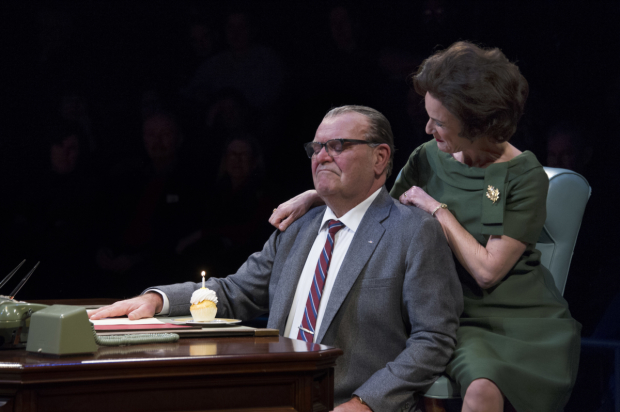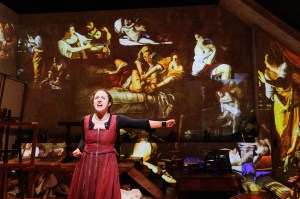Robert Schenkkan Constructs The Great Society in His All the Way Sequel
Arena Stage looks squarely at the presidential life and legacy of Lyndon Johnson.

(© C. Stanley Photography)
Arena Stage has brought Washington many plays that are marginally political, but its latest Washington premiere — of Robert Schenkkan's The Great Society — is unabashedly, completely political, and one of the finest dramas Arena has produced in recent years. A follow-up to his play All the Way, which told the story of Lyndon Johnson’s unexpected appointment as president immediately after the assassination of John Fitzgerald Kennedy, The Great Society makes clear the struggles Johnson went through during his second term.
As the 36th president, LBJ fights to keep a stable relationship with many people, including Martin Luther King Jr., Senator Robert F. Kennedy, Ralph Abernathy, Mayor Richard Daley, and members of his cabinet and Congress. The play takes place between January 1965 and December 1968. Throughout that time, Johnson is shown to be a master manipulator of his friends and foes, and a supreme political operator, being well-versed in understanding how to achieve the policies he felt were most appropriate for America.
Johnson makes it clear from the beginning what his "Great Society" must consist of, including domestic programs for health and education, and bills to address poverty, wilderness preservation, environmental protection, and civil rights. Schenkkan depicts America and Johnson learning just how costly the Vietnam War will be and how much of that domestic agenda must be sacrificed in order to send increasingly large numbers of troops to Vietnam.
The violence that gripped the United States during Johnson's presidency is very graphic in the play. Major riots are shown breaking out in Harlem, Los Angeles, Mississippi, and Atlanta. The riots usually involve three groups: the police using flashbangs and tear gas, white citizens shouting "Two, four, six, eight, we don't want to integrate," and African-American citizens trying peaceful marches under Martin Luther King, or Black Power marches under Stokely Carmichael.
Jack Willis disguises Johnson's ruthless wit with an easy, down-home Texas drawl along with some raunchy, foulmouthed humor, which Johnson often used to throw his political enemies off guard. Bowman Wright is forceful as King, who insists that his followers stick to a nonviolent path. Lawrence Redmond plays up Vice President Hubert Humphrey's feeling of being underappreciated. As George Wallace, Johnson's primary political enemy, Cameron Folmar draws upon the vicious side of the man who tries to hinder Johnson's push for civil rights at every turn.
John Scherer is excellent as Senator Robert Kennedy, who tangles with Johnson mainly because their mutual interest in education forces them to work together. Scherer's Kennedy is a sympathetic character who simply can't abide Johnson's personal style. Tom Wiggin is outstanding as Robert McNamara, Johnson's Secretary of Defense, who tries to guide Johnson through the throes of Vietnam but finally gives up on the war and government work. Wiggin remains calm and cool as the disaster in Vietnam grows and he runs out of options to refer to Johnson.
Jaben Early is a standout as Stokely Carmichael, the founder of the Black Power movement. Richmond Hoxie plays J. Edgar Hoover with just the right amount of creepiness.
Director Kyle Donnelly keeps the action moving crisply, while
Kate Edmunds keeps the set simple, with a design of the rug in the Oval Office being the mainstay of the stage. Johnson's desk and chairs are rolled in and settled in various places to keep changing the production's focus. Nan Cibula-Jenkins's costumes highlight the 1960s with dark, boxy suits for the men and bright-colored, well-fitted dresses for the women. Projection designer Aaron Rhyne creates visuals that illustrate riots in various cities.
It's a telling coincidence that on the night The Great Society opened at Arena, Congress was still debating the budget long after midnight. But perhaps there's cause for hope. Despite the threat to some of the domestic programs that Johnson fought for, if the message of the play gets through, Americans might realize that they need to fight for those things in the same determined way that Johnson did.











